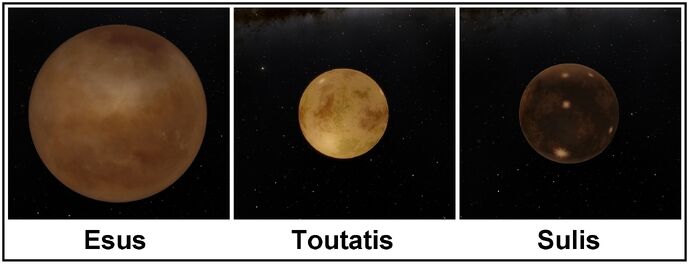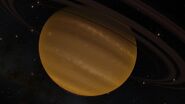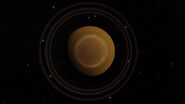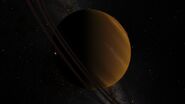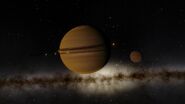Overview[]
Taranis is a frozen gas giant located in Aylathiya. It is the sixth planet of the Belisama system and became famous for being the place were exotic life was first discovered by humanity. Taranis was named after the Celtic god of thunder because of its frequent storms and violent weather.
The planet was discovered in 2453 CE in a scientific expedition to investigate the possible existence of life on the ocean planet Nodens of the Belisama system. As hoped, complex life was found in Nodens, but surprisingly, turns out, it was not the only planet in the system harboring it. After a routine investigation of Taranis, it was found that the gas giant also had a rich ecosystem hidden beneath its clouds. More importantly, all life in the planet seemed to consist of the first discovered ammonia-based organisms, proving once and for all that life could exist based on solvents other than water. Since then, a research base was established on Esus, one of Taranis’ moons, and became an important site of study for the planet and its life forms. This unexpected finding laid the foundation to the ELRP (Exotic Life Research Program).
Orbit[]
Taranis orbits Belisama, an orange dwarf (K-type main-sequence star), at a distance of around 3.2 AU. Its orbital period is of approximately 6.7 years and its rotation period is close to fourteen hours. Considering the distance from its parent star, the atmosphere of Taranis is rather cold, with subzero temperatures. At around 400 kilometers deep however, temperature reach a comfortable 20°C (68°F) in which ammonia (CH3) exists in liquid state because of the high pressures (80 atm~), allowing life to thrive. The planet’s 87º axial tilt creates interesting seasonal effects, altering between long periods when both hemispheres are illuminated and when only one hemisphere receives light while the other is kept in total darkness. This however do not affect the planet’s life since almost no light reaches the depths were it exists.
Moons and rings[]
Taranis has a total of twenty three moons orbiting it (including dwarf moons). The largest moon is Esus (9th moon, 6.1 in SE), a temperate desertic terra with 6530 km in diameter. It is located close to the planet at around 180000 km away. This proximity creates strong tidal forces that keeps the moon tidally locked and geologically active. As a result, several volcanoes exist on Esus’ surface, warming it to temperatures of about 24ºC (75°F) and creating a thin CO2 atmosphere. Other worth mentioning moons are Toutatis (10th moon, 6.2 in SE), a frozen selena with 3447 km diameter and Sulis (12th moon, 6.3 in SE), a frozen planet 3828 km in diameter. They are located at approximately 240000 km and 700000 km away from Taranis respectively, both tidally locked to the planet and with temperatures of about -175 ºC (-283 ºF).
Another interesting feature of Taranis is its rings, that although not as impressive as others, are still a sight to behold. They are brownish in color and are composed of various sized rocks and ice. The rings most likely came from the remnants of a moon or large asteroid that collided with the planet a long time ago, but it is also possible that material ejected from Esus’ volcanoes contributed to their formation. Like many ringe worlds, Taranis rings are classified by letters. There are four main rings, from widest to narrowest: A, B, C and D. Of those, A, B and C are denser while the innermost D ring is very faint. B and C are subdivided in B.1 (wide) and B.2 (narrow) for the first and C.1, C.2 and C.3 for the latter. The rings are separated by empty gaps, the widest being the A-C gap and the narrowest the A-B gap. Smaller gaps also exist between the C and B sub-rings.
Internal structure[]
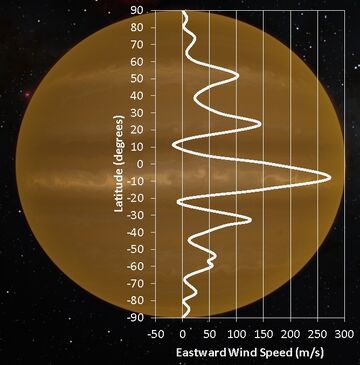
Taranis’ wind speed at different latitudes.
Since Taranis is a gas giant, it shares many characteristics with other Jovian planets. The planet is mostly comprised of hydrogen and helium, with a higher concentration of heavier elements deep inside it. It is also relatively light compared to other gas giants, resulting in a weaker surface gravity (8.4 m/s²). The planet's interior can be divided in four layers:
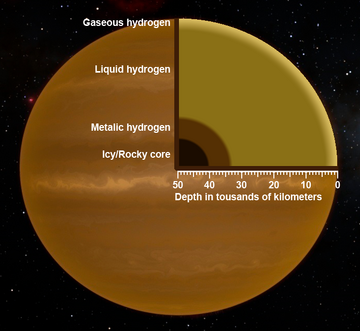
Taranis’ internal structure.
0-2400 km: The only place where life can be found. This layer consists of a mixture of H2, He, CH4 and N2 with traces of other gases and clouds / droplets of mostly ammonia. Water clouds exist too, but they are rare and highly toxic to the life of the planet. Winds in this region can reach up to 1000 km/h in the equatorial region, but are significantly slower in higher latitudes. There are also vertical wind currents moving between the cloud tops down to 2400 kilometers deep.
2400-35000 km: The largest layer both in volume and mass, here the ambient is too extreme for life to exist. In this conditions hydrogen starts to become liquid due to the enormous pressure, and temperatures can reach up to 4400°C (8000°F). This heat causes slow but steady convection currents that keeps the upper layer warm.
35000-42000 km: At this depth density can reach more than 17000 kg/m³, with pressure and temperature becoming so great that liquid hydrogen becomes metallic. This coupled with the planets fast rotation produces its magnetic field, that although powerful, is pretty weak for gas giant standards. This happens because Taranis is much less massive than most gas planets, resulting in a thinner metallic hydrogen layer.
42000-51000 km: The last layer is the planets core. Its exact composition is unknown, but it is most likely made of a variety of ices surrounding a rocky interior. It’s estimated to be about 19113 km in size and at least 7 times as massive. Another possibility is that the planet initially had a solid core in its formation, but it is now spread through the metallic hydrogen mantle due to billions of years of sustained erosive processes caused by the metalic hydrogen mantle convection currents.
Exotic life[]
Taranis hosts a rich and diverse ecosystem, with no civilizations or intelligent life detected. Despite being classified as exotic for using ammonia instead of water, life in Taranis is still carbon-based, and so could also be considered organic depending on the exotic life definition used. Nevertheless, the discovery of ammonia based organisms was a huge finding at the time and changed humanity's understanding of life forever. Another important discovery is that all organisms in Taranis breath hydrogen (H2) and exhale methane (CH4), similarly to what was speculated on other hydrocarbonia objects. Since almost no light reaches the suitable regions for the existence of life, photosynthesis cannot take place. Instead, life obtains its energy from the atmosphere itself by using the kinetic energy of the fast winds to produce organic compounds like acetylene (C2H2), ethylene (C2H4) and ethane (C2H6). This process became known as kineticsynthesis and is possible thanks to microscopic organelles similar to cells. This structures are sensitive to the wind movement around them, vibrating in specific frequencies to produce the organic compounds mentioned above. The reaction also requires H2 and CH4 to happen, both plentiful on Taranis’ atmosphere. Nevertheless, not all organisms produce their own energy, with many being predators, parasites and detritivores.
Ecology[]
Compared to lively and diverse worlds, Taranis doesn’t have many different environments and as a consequence its life is much less diverse (despite being vastly more numerous). Fewer natural barriers (like oceans and mountain ranges) mean that almost all species can be found everywhere on the planet, and while there are some species living in floating islands, they are not as diverse as land life on terrestrial planets. This happens mostly because changes in latitude do not result in changes of temperatures, as all heat comes from the planets interior. A minor increase in gravity is present in greater latitudes because of the rotational flattening of the planet, but this alone do not affect life enough to account for what could be considered a different environment. However, latitude still produces two main biomes that can be well distinguished: zones and belts.
In a sense, zones and belts could be compared to rain forests and deserts respectively. Zones are regions with ascending wind currents. They appear as wider, lighter stripes on the planet's atmosphere (because of the surfacing ammonia clouds) and host most of the life on the planet. The upward winds bring nutrients from bellow and help organisms to stay afloat, creating a rich environment for life. Belts on the other hand appear as dark narrow regions with strong descending wind currents that drags both nutrients and living beings down to the planets interior. As such, belts are the main natural barrier on Taranis, but that doesn’t stop species to pass through them when necessary, or even live in these regions.
Another possible division of biomes is a vertical one. Temperature and pressure change greatly within the 400 km range were life is present (200 to 600 km), creating layers with significant differences in species composition. Some organisms are adapted to live in the cold and less dense upper layers, while others live under high pressures and temperatures closer to the planets interior. There are also those that can live in both environments, transiting seamlessly between them when necessary, and even those that depend on the existence of this gradient of conditions to survive. Thus, the diversity of life in Taranis relates more to variations in depth than in latitude.
Origins and classification of life[]
Little is known about the origins and evolution of life in Taranis since fossil records are nonexistent, but the most accepted hypothesis is that it was originated on the planet by abiogenesis in the atmospheric currents. It is believed that the relatively low surface gravity of the planet had an important role to the development of life, allowing simple early organisms to survive long enough to reproduce before falling to lower levels were temperature and pressure is too high. These organisms disappeared from the atmosphere of Taranis a long time ago, but many complex life forms evolved from them over the long 11.6 billion years of the planets existence. As difficult as it is to study Taranis' life origins and classification, five main groups were identified. They are:
- Priusaera (prius: before, aera: air): These are the earliest and most primitive life forms on Taranis. They are all unicellular, but some of them can be seen by the naked eye as all life on the planet have very large and low density cells if compared to other organisms. Despite lacking any mechanism to control their internal density, they have many different strategies to stay afloat, like the presence of structures similar to cilia that both increases surface area and vibrate with the winds to collect energy. Some also have very complex shapes resembling snowflakes that can move and change to take advantage of upward wind currents. It is also very common to find them living entangled together in colonies of different sizes. They are all primary producers and can be divided in three main groups: acetylene producers, ethylene producers and ethane producers, being the only organisms capable of producing ethylene or ethane (much less efficient processes unsuitable for complex life). Probably an older consumer branch of this beings existed, but is now extinct due to competition.
- Aerifera (aera: air, fera: bearer): The Aerifera (or simply Aera) are directly originated from the Priusaera. They too are unicellular organisms, but unlike their ancestors they are able to regulate their internal pressure with pockets of hydrogen inside their cells, an adaptation considered as important as the development of the nucleus in the early stages of life. This ability gives the Aerifera an important advantage over the Priusaera, allowing for a much increased complexity and an enormous diversity of shapes, sizes and surviving strategies. They can be divided in producers and consumers, as well as by the number of hydrogen pockets present in them. One of their most successful evolutionary branches are the Vesicae (vesica: ballon), macroscopic single cellular beings with one single large hydrogen pocket. The Vesicae are the dominant primary producers and they are estimated to represent more than 60% of all biomass on the planet. They also originated the Zephyri, another major group of arganisms.
- Colonaria (coloniam: colony): The Colonaria are somewhere between unicellular and multicellular. They are very simple, with only a few cells (there are some exceptions) and behave more like a colony of single cellular organisms than a whole entity. Many of them are parasitic in nature and leave attached to bigger life forms like those of Zephyri and Fistulifera branches, but some species can float on their own or in groups. The main difference between them and single cellular colonies is the existence of cells that execute specific tasks (e.g. feeding, protection and reproduction). Whether they are another branch of the Aerifera or much more ancient organisms related to the supposed extinct Priusaera consumers remains a mystery. The main issue is that they are all consumers like some Aerifera, but have no hydrogen pockets in their cells and most likely originated from colony forming beings (a more common Priusaera behavior). Further understanding of their complex alien genetic structure may answer these questions in the future.
- Zephyri (zephirus: wind): Direct descendants from the Vesicae, the Zephyri are the most complex lifeforms on Taranis. They are all multicellular primary producer organisms and many of them have a similar role to plants on terrestrial objects, providing food and shelter for other species. Their main characteristic is the presence of one or more balloons of hydrogen that allows them to float. They are the only endothermic beings in the planet and are able to heat the gas inside their balloons, allowing them to change their density very efficiently. Like the Vesicae, their cells also have an internal hydrogen pocket, which further improves their floatability and allows some of them to reach kilometers in size. Because of this they also have a very important role as floating islands in which countless organisms live in. Some species are also found in colonies, forming large forests of balloons entangled in vines systems that collect energy from the winds. Other species of Zephyri are not as passive, with some of them being very aggressive and even predators. The difference is that they do not hunt for organic matter, but for pure hydrogen gas that can be found in hot air balloons in other species of the same group. Despite that, it’s very rare to find a hydrogen hunter that actually kills its prey. A much more common scenario is a mutualistic relation in which gas hunters protect their prey from the true predators of the Fistulifera branch in exchange for a pure hydrogen supply and shelter.
- Fistulifera (fistula: pipe, fera: bearer): Another complex group originated from the Aerifera, but from a consumer branch known as Polypera (poly: many, pera: bags), the Fistulifera are either predators, parasites or detritivores. They have a variety of shapes and sizes, but as the name implies, they are all made of tubular structures denominated fistula with the main function of filtering air to absorb nutrients. The largest of this beings can reach hundreds of meters, moving slowly through the skies devouring thousands of small organisms in their way (very similar to what whales do). Others actively pump air through their many fistulae while floating or attached in the huge living islands of the Zephyri group, resembling sponges filtering water in oceans. The predator species are also very diverse, detecting pray by sound, heat or smell in the pitch black environment of Taranis. Some can devour smaller creatures in a large mouth like fistula and some shred their prey with sharp blade appendages to filter the air now filled with food. Others live borrowed in the great islands, slowly eating them from inside out, or live as deep as 600 km at extreme high pressures and temperatures to harvest the dead creatures from above.
Interesting species and groups[]
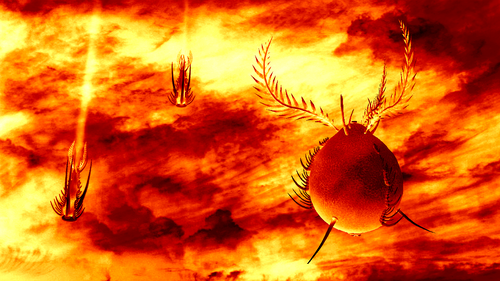
Thermal image of deep divers in different life stages taken by a probe at 473 km deep.
Deep Divers: The Deep Divers are a group of short lived species of the Zephyri branch. They have one single balloon on their core and three developed hardened long structures around it for protection. In their early stages the balloon is deflated and its internal walls are full of vibrating cilia for energy gathering. They spend most of their early life falling fast through the skies collecting energy from the winds and when they come to the depths (the exact depth varying from species to species) they use the energy collected to mature, inflating their core balloons with hydrogen. Then they slowly go back to the higher layers they were born to reproduce, bursting into many fertile spores that will hopefully develop into new divers and restart the cycle.
Filtering Carpet: The filtering carpet is an interesting species consisting of flat and wide organisms of the Fistulifera branch that stay as low as 600 km deep to gather dead matter that falls from the upper regions. They usually dwell in the edge between zones and belts, were most of the dead matter falls to the planets interior. This is a very risky strategy, as many of them die because of the sudden wind currents that knock them a few kilometers too low. Like the majority of the Fistulifera, they reproduce by detaching one of their fertile fistula that will either replicate itself asexually or, with a little bit of luck, combine to another lone fistula of the same species to form a different organism.
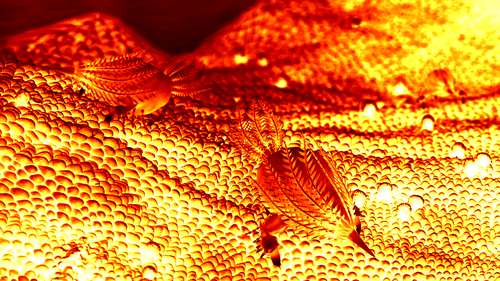
Thermal image of gas ticks walking in the surface of a living floating island in search for a place to feed.
Gas ticks and midges: Much of the life in Taranis revolves around the living floating islands, and gas ticks and midges depend on their existence to survive. These are also organisms from the Zephyri group, but unlike the majority of the Zephyri, they don’t have any way of extracting energy from the atmosphere. What they do instead is puncture the pressurized hydrogen balloons of the floating islands with long appendages full of vibrating cilia. The gas passes at high speeds trough these organs, giving the necessary energy for those organisms to survive and reproduce. The main difference between ticks and midges is that ticks normally remain stationary in the gas islands once they start to feed, while midges move independently and can feed from many different places. Ticks also have stunted balloons and can’t float on their own, while midges are agile and are adapted to fly short distances with ease. Gas ticks and midges may share similarities with animals, but some of them can reach several meters in size (still tiny by Taranis’ standards).
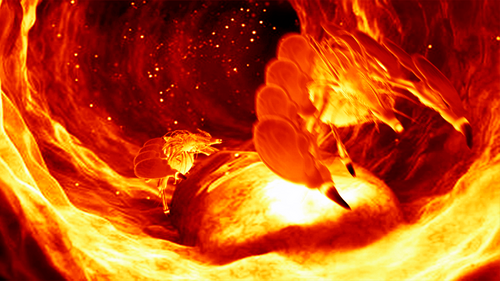
Thermal image of gas bees inside their floating hive. The hive supplies its bees with pressurized gas (energy) and in turn benefits from their protection.
Floating Hives: These organisms are a type of floating island that hosts a group of gas midges called gas bees. Like any gas midge, gas bees get their energy from puncturing other zephyri pressurized balloons, but unlike them, they are not considered parasites. Floating Hives and gas bees share a mutualistic relation in which the hive provides shelter and free pressurized hydrogen (energy) for its bees while the bees protect the hive from parasites and predators. Other benefits to the hive include a supply of nutrients (excreted by the bees), hydrogen (stolen by the bees from other sources) and reproduction (the bees carry their hive’s fertile spores to other individuals of the same species).
Floatshrooms: A type of fungi-like Colonaria that live on the surface of Floating Hives. Much like Gas Ticks, they poke holes inside their host creature to gather gas, which is used to fill internal balloons. After a Floatshroom gathers enough gas, it detaches and starts to float. It does not get much gas and floats down to about 620 km deep at deepest. If a dead Filtering Carpet falls onto a Floatshroom, the Floatshroom begins to fall. However, sometimes a wind current lifts the two up, where the floatshroom attaches to the Filtering Carpet and feeds off of it, as fungi do. It has "roots" which drill through the filtering carpet. After it grows its farthest, smaller floatshrooms grow from the roots. Once the Filtering Carpet is depleted, the smaller floatshrooms detach. Some are filled with gas from their parent Floatshroom and float up to reach the Floating Hives, where the cycle repeats. The original floatshroom no longer has its air and falls, along with the Filtering Carpet, down. The Floatshroom can no longer get food and dies, which weakens its structural integrity. It detaches and is broken up. The Filtering Carpet is killed if it goes deeper then 610 km, but is destroyed when it reaches 650 km. It too breaks up.

